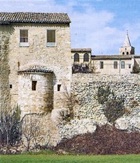
This photograph from outside the walls depicts:
the apse of Santa Maria de Ponte Lapidum (to the left);
part of the nunnery of Santa Maria del Monte (to the right);
and the campanile of San Francesco (behind it)
The nunnery of Santa Margherita is described on its own page in this site.
Santa Maria de Ponte Lapidum
This ancient nunnery was named for an ancient stone bridge (no longer extant) that took the Roman decumanus maximus across the Clitunno (see Walk II). It was absorbed by Santa Margherita in 1476.
Santa Lucia (1272)
A noble woman called Lucia, a follower of Blessed James Bianconi, founded this nunnery in what is now Corso Amendola, with its church (evidenced by a damaged fresco (15th century) of the Madonna and Child above the portal) at number 43 and Piazza dell’ Asilo. The nunnery was absorbed by Santa Margherita (above) in the late 19th century.
Santa Maria del Monte (14th century)

Rainaldo dei Conti Antignano founded a nunnery with this dedication in 1198 on a site near his castle at Monte delle Civitelle. It adopted the Benedictine rule at the behest of Bishop Bartolomeo Accaraboni of Spoleto in 1244.
The nuns moved to the present site in 1555, and the church was established in what had been the house (14th century) of the Andreozzi family, with the nunnery to the left of it. (The back of the nunnery is illustrated at the top of this page).
In 1728, Pietro Andreozzi acquired the relics of St Dapsa Sofitea in Rome and gave them to the nuns. He also gave them the bronze altar frontal that is now in the Cappella del SS Sacramento, which was originally under the high altar, where the relics were preserved.
The nunnery was suppressed in 1810-5 and again in 1860, but the nuns succeeded in buying it back in 1899. The monastery was restored in 1962-78 and adapted as a hotel. Ring for admission at number 15, Corso Giacomo Matteotti. The church was in restoration during my visit in April, 2010, and I never succeeded in persuading the nuns to let me see it.
Church
The façade of the church has two 18th century portals that flank the remains of the original central portal.
Assumption of the Virgin (18th century)
This altarpiece, which is attributed to Etienne Parrocel, il Romano, is on the high altar.







